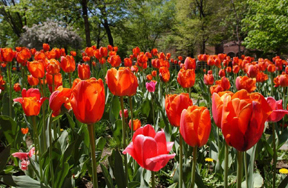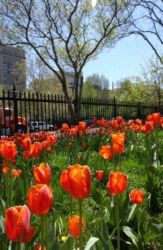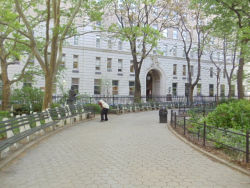Stuyvesant Square
The Daily Plant : Friday, May 9, 2003
THE NEW TULIP FOR THE NEW WORLD

Photo by Spencer T Tucker
After a cold winter underground, an electric orange flower sprouted through the wet soil of Stuyvesant Square Park this past month. The Manhattan Tulip, its official name, has never grown in New York City before. In fact, this spring marks the first time this flower has officially existed anywhere in the world. It was named after the island where the Dutch founded today’s New York City and was specially created as a tribute to New Yorkers. The Manhattan Tulip is like no other tulip in the world, and it has bloomed just in time to celebrate the 100th Anniversary of the Netherland Club of New York and the Netherlands Chamber of Commerce.
The creation of a unique tulip is a slow journey. The Manhattan Tulip took horticulturists over a decade to develop. "It’s really a labor of love," said Jan Doornbosch, President of the International Bulb Company, which is based in Montvale, New Jersey, and which is one of the principal participants in the Manhattan Tulip Project. Working with the Netherlands American Community Trust and the Netherland-America Foundation, they developed, cultivated, and planted this original flower for New Yorkers to enjoy.
To understand how this new flower came to be, one needs to understand the two methods used to introduce new tulips. The first method, cross-pollination, involves the mating of two different types of tulips and then selecting from their offspring the one flower with special characteristics you desire. The second way, spontaneous mutation, occurs when, among a field of a particular tulip, a random variant appears (a pink tulip among a field of reds, for example).
The Manhattan Tulip dedicated yesterday was created by cross-breeding. Over a decade ago, two distinct species (a Red emperor and a Gander) were cross bred to produce between 100 and 150 seeds. Those seeds were then planted. It then took more than five years before the plants were mature enough to bloom, and the first flowers appeared. Of the hundred flowers generated, each one was different. Cross-breeding "unlocks all the genes in the plant," said Mr. Doornbosch.
Only two out of 1,000 seedlings are selected," he said. "The rest will be discarded." He explained that when breeding a new flower, he considers many factors, including whether it’s an improvement from what already exists and whether it is new on the market. Once the grower decides a new bulb is valuable, it takes several years before the single bulb is of sufficient quality and quantity that it can be introduced to the world.
"We were looking for an orange tulip because the flag of New York is orange," said Mr. Doornbosch. "The royal family from Holland is from the House of Orange." Once they had found the right bulb, they had to bring their prized flower before a committee in Holland to determine whether the name was available or whether it already existed. Names such as New Amsterdam and others were bounced around before the Manhattan Tulip was finally chosen. Although a flower with that name already existed, the International Bulb Company was able to secure the name rights for their flower.
The final stage of the birth of this new tulip did not occur until this spring, when the flower bloomed for the first time in Holland (which occurred several weeks earlier than in America this year). When the flower sprouted from the earth, a panel of judges needed to determine whether the bulb was unique. They did, and the Manhattan Tulip was born. When it grew weeks later in America, the flower was officially known as the Manhattan Tulip.
On Wednesday, Parks & Recreation Deputy Commissioner for Operations Liam Kavanagh, Parks & Recreation Manhattan Borough Commissioner Bill Castro, the Netherlands Chamber of Commerce in the U.S., Inc. representative Janina Breuer, Rabobank Representative Wendy Bellus, Mr. Doornbosch, and Cultivator of the Manhattan Tulip John Boots joined in Stuyvesant Square Park to welcome the new flower to the island it was named for. At the event, Commissioner Kavanagh accepted a donation of 5,000 bulbs to Parks & Recreation for planting this fall. And, as anyone who visits the park will see, the beauty of these flowers was worth the wait.
Written by Eric Adolfsen
QUOTATION FOR THE DAY
"Literature is news that stays news."
Ezra Pound
(1885-1972)
Check out your park's Vital Signs
Clean & Safe
Green & Resilient
Empowered & Engaged Users
Share your feedback or learn more about how this park is part of a
Vital Park System








